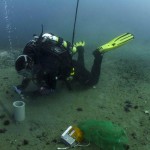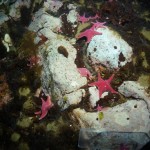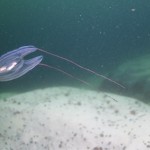Marine biology at Rothera
Apart from visiting field scientists, there is a lot of science that is done right out of Rothera. Marine Biologists work out of the base all year round, diving through the ice if need be. I went out on the dive boat on Friday to help out and see what happens.

Belinda (Bel) is a marine biologist and has dived all over the world. In the past, she has worked as a commercial research diver as well as a dive guide and marine biologist. Here, Bel is undertaking a survey of the animals that live in the soft sediments around Rothera. In this dive, she is undertaking a site survey. Bel will be measuring the depth and composition of the sediment and describing and photographing the soft sediment. Once Bel has surveyed a number of sites, she will choose a couple with suitable benthic soft sediment communities for her studies into the species that live here and the energy flow (carbon) through them.
Rothera is well equipped for diving, with a dedicated marine biology laboratory (The Bonner Lab), an aquarium, a library, a decompression chamber, several dive boats, and extensive diving equipment. The decompression chamber is the only one in this part of Antarctica, and the doctor and dive officer have special training so they know how to use it. There are several marine biologists and diving assistants on base, who do up to two dives per day for a maximum of three days in a row. After three days of consecutive dives they are ‘dived out’ and will remain topside.
Diving at Rose Garden

The divers operate in a team and use small boats for their work. On Friday, I went out with them on The Nimrod (a Humber; a RIB or Rigid Inflatable). The team consists of Bel (Marine Biologist), Paul (Diver and Boatman and Bel’s buddy), Phil (Diving Officer), and Tim (Boating Officer). The divers always dive in pairs. Bel will be undertaking her survey, and Paul will be assisting and watching out for seals. Tim drives the boat, and Phil looks after the health and safety of the divers.
The divers need to wear very warm downy suits (a bit like a baby grow) and drysuits over the top. All the other people on the boat wear boat suits, which are also drysuits with neck and wrist seals, so that you will remain dry if you fall overboard. We all put these on in the wet room in the Bonner Laboratory, before heading out on the boats.
The boats are lowered into the water by a crane. Normally they would go down a slipway, but the one at Rothera was repeatedly damaged by icebergs. Climbing down a rope ladder into the Humber in an ill-fitting drysuit with bulk gloves and welly boots takes a bit of nerve!

We headed out towards Donnelly Island to a dive just east of a site called Rose Garden. Bel wanted to make a survey of the soft sediment here, measuring its depth and describing it. They planned a dive to a maximum of 24 metres depth for 25 minutes. Once we arrived at the site, we needed to undertake a 30 minute seal watch. Leopard seals are known around Rothera and could attack a diver, so we maintain seal watch for 30 minutes before the divers entered the water, and then throughout the dive. We saw crabeater seals and many elephant seals, but no leopard seals.
Preparing to dive

Bel and Paul quickly donned their diving equipment. They have one tank of compressed air and one small emergency tank each. They wear a neoprene hood and a full-face mask, as well as neoprene gloves. No skin shows anywhere. Bel explained to me that her hands get the coldest and that the gloves are a compromise between being able to operate her camera and keeping her hands warm. Unfortunately, in order to be able to do her work, her hands must suffer. The mask has a built-in radio and both divers press a button on their mask to be able to talk to each other and topside.

Phil assisted Bel and Paul with their equipment. It is bulky and difficult to move with it on, so Phil put on their masks and gloves, and ensured that they knew the direction they would be swimming in. All divers dive with a float that is attached to them, and they are also attached to each other. Both divers carry knives in case they become entangled in the rope. In addition to this, Paul carried a large metal prod to defend them both in case of seal attack.
Diving in cold waters
Once fully attired, Bel and Paul quickly and without fuss entered the water backwards and began their descent. We followed their bubbles in the boat, and positioned the boat above them. We heard an excited, “Bel! A fish!” from Paul during their descent. As they went down together, we could hear them discussing the poor visibility over the radio.
With only 25 minutes to work with, Bel quickly began her survey. Intermittently, she would call out a sediment depth over the radio and make any observations (“Lots of weed”; “Bedrock”). She would then take an underwater photograph. Tim positioned the boat directly above their bubbles and made a waypoint with the on-board GPS. I recorded Bel’s observations and measurements and the waypoint. Using her wrist-mounted compass, she made a systematic survey of the rocky sea floor. Apparently, there was very little in the way of soft sediment and their associated communities at Rose Garden.
Ascent and recovery

When the divers had been down for 20 minutes, Tim informed them that they had 5 minutes left. They began their ascent, waiting at a safety stop at 6 m for 3 minutes. Phil collected in their rope as they came up. Before long, they were on the surface. They swam over to the boat, and Phil and Tim quickly and efficiently each helped one of the divers remove their tanks, weight belts and masks. Bel and Paul quickly and easily hauled themselves into the boat. They both obviously had very cold and uncooperative hands, which Phil and Tim forced into ski mittens. Both divers were wrapped in jackets and we shot back to base.

Once back in the Bonner Lab, Paul and Bel rinsed their drysuits in hot, fresh water, warming their hands in the process (“It burns!”) while Tim and Phil put the boat away. Then it was time for a hot cup of tea and some coffee cake made by another member of the team. Another successful dive. That afternoon, Bel and Paul would be out diving again.










Awesome article.